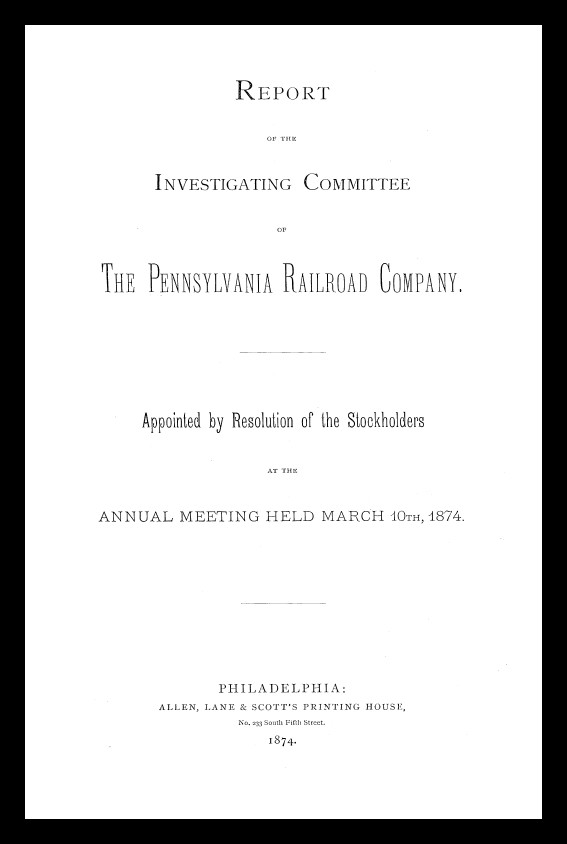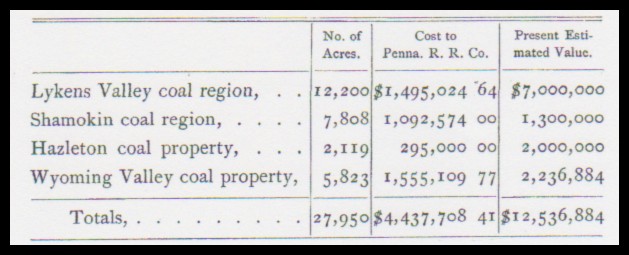in 1874, for the Annual Meering of the Stockholders of the Pennsylvania Railroad at Philadelphia, a Report of the Investigating Committee of the Pennsylvania Railroad Company was produced.
Article VII of the report concerned the “Coal Lands.” There were six parts of that section, with the two parts italicized and in boldface, presented here.
- Lykens Valley
- Shamokin Region
- Hazleton Property
- Susquehanna Coal Company
- Policy of Owning and Working
- Transportation of Coal
____________________________________
COAL LANDS
The coal properties owned wholly or partly by your Company in the anthracite regions of our State are located in the Lykens Valley, at Shamokin, near Hazleton, and at Nanticoke Dam, in the Wyoming Valley, and embrace an aggregate of twenty-seven thousand nine hundred and fifty acres.
____________________________________
The Lykens Valley
Coal property is situated about twenty miles north-east from Millersburg, on the Susquehanna. The lands lie in a contiguous block, extending about nine miles, containing an area of nine thousand two hundred acres. No other company has access to these veins.
In addition to the nine thousand acres of coal land there are about three thousand acres of valley land, mostly valuable for agricultural purposes. Owing to the great depth of the basin at Bear Gap, as well as the quality of the coal contained therein, this coal land is of more value than any equal number of acres in the State.
The quality of the Lykens Valley coal, which thus far has been the only coal worked in this region, is well known. The price averages at least seventy-five cents per ton higher than any other anthracite coal, with an increasing popularity and a demand resulting therefrom which makes this, perhaps, the most valuable coal property in this country, not only from its vast extent, but from the fact that its coal, from its quality, is at all times in active demand. A very low estimate from actual surveys makes the workable coal of these lands equal to one hundred million tons.
The precise ownership of your Company in the Lykens Valley coal lands is somewhat difficult of exact expression. The Summit Branch Railroad Company virtually owns the whole region, because in addition to its own property it owns seven thousand eight hundred and eighty-three shares of Lykens Valley Coal Company’s stock. It has also claims for money advanced to the latter company amounting to $964,889.38. This is equal to the full ownership of the Lykens Valley property. Your company owns forty-three thousand eight hundred and four shares out of eighty-two thousand five hundred shares of the whole capital stock of the Summit Branch Railroad Company. You acquired the ownership of this stock at different times and different prices, the aggregate cost for the whole interest being $1,495, 024.64.
There are four collieries and breakers upon this property, with an average daily capacity of three thousand five hundred and fifty tons.
The purchase of the Lykens Valley property, under the circumstances, was most judicious. It was purchased at an early period, at very low figures, and entirely in accordance with the most conservative policy. The Northern Central Railroad, a majority of whose stock is held by you, was dependent upon these regions for traffic to Baltimore, and intermediate points. Securing these coal properties gives this road, east from Harrisburg, and the canal interest you hold from Millerburg, a valuable tonnage for a great many years to come.
The value of this coal property must increase; and in the judgment of the committee the management is wise in its determination that its product shall be mined only as the trade may demand, at largely remunerative prices. It is a property so valuable, so accessible to the market, with a coal that must increase in popularity and in consumption each year. The property should be worked, therefore, only to supply the immediate demand. Full rates are charged to transport this coal, so that your Company obtains, in addition to the profit on the coal, a very large sum for its carriage. The manifest skill, care, and vigor with which the business is conducted is deserving of special commendation.
The Summit Branch Company, in addition to the above, owns property, not immediately located in this valley, worth perhaps, $150,000.
_________________________________
Transportation
As the subject of transportation has occupied considerable attention, it may be well to suggest that what seems to be absolutely required in the movement of coal, from both the Lykens Valley and Shamokin region, is that the Company should be placed in position to control eastern shipments which now largely depend upon the Reading Railroad. The purchase of six hundred or one thousand cars by the Summit Branch railroad would enable shipments to be made directly to Greenwich, on the Delaware, instead of over the Reading Railroad to Port Richmond. When there is a brisk demand for cars the Reading Company may use their cars for mines of their own, and thus limit the production of these properties. This ought to be changed, and the Summit Branch Company or your Company and the Northern Central should furnish cars for the full movement of coal produced when the profit is satisfactory. The freight from the Lykens Valley region last year was four hundred and fifty-nine thousand one hundred and fifty-nine tons, and from the Shamokin region two hundred and forty-seven thousand three hundred and seventy-six tons. The average cost of carrying this coal last winter was as follows: – To Dauphin forty-two and one-half cents, to Richmond one dollar and eighty and thirteen one-hundredths cents, making a total of two dollars and twenty-two and sixty-three one-hundredths cents. If this was carried to Greenwich over your line, retaining the forty-two and one-half cents charged on the Northern Central railway, it would have a haul of one hundred and twenty-five miles, and a rate per ton per mile of one and forty-four one-hundredths cents; or if prorated with the Northern Central, the rate for both companies would be one and fifty-four one-hundredths cents per ton per mile. The net profit on this business (now given to competing lines) would amount, from the Lykens Valley trade alone, to $200,000 per year. The amount paid for freight to the Reading Company on coal from the Lykens Valley, during 1873, was $406,208.30. The total amount of freight paid to the Reading Railroad Company for the transportation of coal from the Lykens Valley and Shamokin regions, during the year 1873, was $521,933.84.
The shipment of the Susquehanna Coal Company’s product over the Lehigh Valley and Susquehanna Railroads, instead of west and south over the Northern Central and other lines owned or controlled by the Company, has occasioned some criticism. It is but proper to give the facts of the case.
First. – No coal is shipped east over the lines named, except such as our western and southern market will not profitably take.
Second. – The amount shipped east is only about one-third of the whole product. In giving direction to shipments, the officers of the coal company have to regard the profit on the coal as well as the interest of your transportation lines.
In shipping west and south, you carry the coal to its destination over your own lines, except sixty-four miles over the Lackawanna and Bloomsburg Railroad. In shipping east, your own lines do all the work, except from Warrior Run to Philipsburg, a distance of ninety-six miles, It would therefore be to your advantage for shipments to be made exclusively to the West and South, s far as transportation is concerned. But at time one size or variety of coal is dull of sale in one market and active in another. Hence it is most profitable to ship coal to the market that will pay the best price for it, even if it goes a greater distance over some other road.
Annexed is a summary exhibiting the acreage, cost, and estimated value of the coal properties: –
The above we believe to be a correct estimate of value, but the properties being recently purchased and only partly developed, we have taken them at cost in estimating the Company’s assets.
_______________________________________
A complete copy of this report (free download) can be obtained on the web at: Google.
Corrections and additional information should be added as comments to this post.

